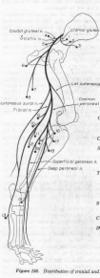I posted on pelvic fractures a while back, and I didn’t really get into the soft tissue complications. They are certainly possible, and I guess what’s really amazing is that we don’t see more of them. You could have the urinary bladder ripped loose from its moorings, or it could be ruptured by the same impact. After any kind of severe trauma, you need to monitor the patient’s urine output. Sometimes a full bladder is damaged, but doesn’t rupture until a few days later. I once had a cat patient who seemed to be doing well for the first three days after being hit. Then she started getting more depressed and dopey. Her urinary bladder had ruptured and her wastes were pooling in her abdomen instead of leaving by the back door. This is something that’s fixable, but you have to realize what’s going on before it’s too late.
 There are a lot of nerves around the pelvis as well. Right now we’re dealing with a very challenging case. Little Mickey was hit back in July and seemed to have no other injuries outside of the pelvic fractures. With pain control, he seemed to be doing well, and was up walking on 3 legs in a couple of weeks. Unfortunately, he didn’t seem to be using his left hind leg much. The sciatic nerve controls a lot of the leg muscles (as in the diagram) and it certainly could have been damaged in the original injury.
There are a lot of nerves around the pelvis as well. Right now we’re dealing with a very challenging case. Little Mickey was hit back in July and seemed to have no other injuries outside of the pelvic fractures. With pain control, he seemed to be doing well, and was up walking on 3 legs in a couple of weeks. Unfortunately, he didn’t seem to be using his left hind leg much. The sciatic nerve controls a lot of the leg muscles (as in the diagram) and it certainly could have been damaged in the original injury.
Things got worse, and the toes became traumatized from dragging the paw. The owners were unable to keep a bandage on it, and finally Mickey chewed off a couple of toes. With that kind of problem, and no use of the leg anyway, we were forced to amputate. We expected that to be the end of the story, but it is not.
 This should be a happy little stump — plump, round, and slick as a mink. Unfortunately, Mickey continues to chew on his stump. The neurologists believe he is suffering from paresthesia. That means that he has weird sensations as a result of the nerve damage. Everything hooked to the damaged nerve has sensations of prickling, tickling, burning or crawling or something. [Formication: the sensation that small insects are crawling around on you. Not to be confused with that other word that’s almost the same, appearing frequently in the King James version.]
This should be a happy little stump — plump, round, and slick as a mink. Unfortunately, Mickey continues to chew on his stump. The neurologists believe he is suffering from paresthesia. That means that he has weird sensations as a result of the nerve damage. Everything hooked to the damaged nerve has sensations of prickling, tickling, burning or crawling or something. [Formication: the sensation that small insects are crawling around on you. Not to be confused with that other word that’s almost the same, appearing frequently in the King James version.]
There is some hope that the nerve will heal eventually and that this will pass, but nerve healing (if it does occur) can take six months or longer. In the meantime, combinations of medications are used in the attempt to relieve the dog’s distress: opioid pain-killers, anti-inflammatory doses of cortisone, and other drugs whose primary use is something else (like anti-seizure, anti-depressant, etc.), but which seem to help with this.
What a mess. As I said, with the way things are put together here, the great wonder is that it doesn’t happen more often. I don’t know how many pelvic fractures I’ve seen, but this is my first paresthesia. I don’t like it.


I’ve found piracetam helps with nerve growth.
The mechanism of action of this class of drugs is not understood. It generally is believed to enhance some cognitive functions. I don’t think it would hurt anything, but I doubt it would repair a severed nerve.